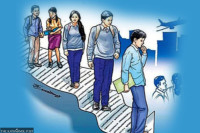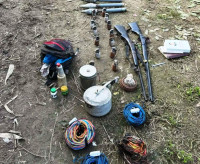National
Getting passports is becoming too arduous a task for many
The Department of Passports in Kathmandu is overwhelmed as service seekers from across the country come to the Capital.
Anup Ojha
Dhan Kumari Sarki came to Kathmandu five days ago from Salyan. She needs an e-passport. Just to get a photo clicked, she has been visiting the passport office for the last three days.
“Since Monday I have been coming here every day from a hotel in Gongabu where we are staying,” said Sarki, 36, who was standing in line at the Department of Passports in Tripureshwar on Friday morning. “For the first two days we were completely lost in the crowd. Now, for the past three days, we have been coming here routinely, staying in the queue and returning to the hotel,” said Sarki.
She says she is planning to go to Kuwait.
On Friday, during the Post’s visit to the Department of Passport between 11:30am and 2pm, over 2,000 people were in a number of queues—for form submission, to get the photo clicked, to renew old passports, passport replacement (lost or stolen) and to collect new travel documents.
Another service seeker was Balaram Rai.
The 33-year-old from Sakela Rural Municipality-3 of Khotang lost his passport. He applied for an e-passport on February 15, more than three weeks ago.
“I was told I would get the passport on Thursday, but after standing in line for the whole day, I could not get it,” said Rai. And on Friday, they told him to come on Sunday.
Rai says despite paying Rs17,000 for the passport, he has been facing hassles. It costs Rs12,000 to get a new e-passport through fast track, which is available only from the department at Kathmandu, and to get replacement for a lost passport, the cost is Rs17,000.
Even though the Department of Passports says it has made arrangements for issuing passports from 60 districts, the department’s Tripureshwar office continues to see passport seekers in huge numbers.

Amish Raj Mulmi, an author and columnist for the Post, on Thursday and Friday posted a series of pictures of the people standing in queues for passports on Twitter.
Mulmi, who the Post met at the passport office on Friday, gave two possible reasons for the crowding—disruption in passport distribution from the districts, and the introduction of e-passport.
He further suggested that the department should urgently take steps to manage crowds either by deploying its own staff or by outsourcing some of the peripheral tasks to private sector firms, to reduce hassles of service seekers.
Officials at the Ministry of Foreign Affairs, meanwhile, attribute the current crowding and mismanagement to the introduction of new e-passport, relocation of the passport department to Tripureshwar from Narayanhiti Palace and sudden resumption of foreign employment with the easing of Covid restrictions.
“The department is still in a transitional phase after it moved from machine-readable passports to e-passports. Also, many people have received the newly-introduced national ID cards and they are queuing to get new passports,” said Sewa Lamsal, joint-secretary and spokesperson for the ministry.
She added that the post-pandemic reopening of international borders and increased flow of Nepali students to foreign universities are responsible for the spike in demand for passports. “We hope the number of service seekers will come down soon—once the pent-up demand for passports is addressed,” she added.
“We are aware of the issue. If the number keeps increasing this way, the ministry will surely intervene and that will be decided by next week,” said Lamsal.
Sharad Raj Aran, director of the Department of Passports, said there is no need for people to come to Kathmandu for passports as they can be received from as many as 60 districts. As many as 13 districts, mainly in the remote mountain areas, have not started the service yet.
“I have always wondered why everyone comes to Kathmandu for passports. The passports issued from here and other districts are the same,” Aran told the Post. If one applies for a passport from their respective District Administration Office, then the cost is only Rs5000, but one has to wait for 15 days. But at the department, it costs Rs12,000 and the passport should be delivered in three days.
“We have the capacity to issue only 1,000 passports a day,” said Aran. “But we are dealing with around 5,000 applications a day. This certainly has caused crowding and hassles.”
According to officials, the department collects around Rs20 million in revenue every day. Asked why the department does not arrange more desks by deploying more staff to reduce the crowd, Aran said that’s beyond his office’s jurisdiction.

Aran said the department had written to the Home Ministry through the Ministry of Foreign Affairs four months ago, requesting for more human resources at different district offices. It also asked the Foreign Ministry to manage additional staffers to handle crowds at the department.
“But we have not received any response from the Home Ministry yet, and the Foreign Ministry itself is working out ways to tackle the problem,” he said.
Currently, the department has 77 staffers, which Aran admits is insufficient given the huge pile of passport applicants.
He said currently each district is issuing only around 30 to 40 passports a day, mainly due to the staff shortages.
A senior official at the Home Ministry, meanwhile, said it is the Foreign Ministry’s responsibility to deploy more officials to the districts which are facing manpower shortages. “Even though we have asked the Foreign Ministry to send computer operators to all 77 districts, many districts don’t have one,” said the official who didn’t want to be named.




 8.12°C Kathmandu
8.12°C Kathmandu.jpg)


%20(1).jpg&w=200&height=120)












